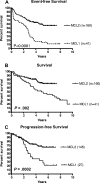Long-term progression-free survival of mantle cell lymphoma after intensive front-line immunochemotherapy with in vivo-purged stem cell rescue: a nonrandomized phase 2 multicenter study by the Nordic Lymphoma Group
- PMID: 18625886
- PMCID: PMC2556606
- DOI: 10.1182/blood-2008-03-147025
Long-term progression-free survival of mantle cell lymphoma after intensive front-line immunochemotherapy with in vivo-purged stem cell rescue: a nonrandomized phase 2 multicenter study by the Nordic Lymphoma Group
Abstract
Mantle cell lymphoma (MCL) is considered incurable. Intensive immunochemotherapy with stem cell support has not been tested in large, prospective series. In the 2nd Nordic MCL trial, we treated 160 consecutive, untreated patients younger than 66 years in a phase 2 protocol with dose-intensified induction immunochemotherapy with rituximab (R) + cyclophosphamide, vincristine, doxorubicin, prednisone (maxi-CHOP), alternating with R + high-dose cytarabine. Responders received high-dose chemotherapy with BEAM or BEAC (carmustine, etoposide, cytarabine, and melphalan/cyclophosphamide) with R-in vivo purged autologous stem cell support. Overall and complete response was achieved in 96% and 54%, respectively. The 6-year overall, event-free, and progression-free survival were 70%, 56%, and 66%, respectively, with no relapses occurring after 5 years. Multivariate analysis showed Ki-67 to be the sole independent predictor of event-free survival. The nonrelapse mortality was 5%. The majority of stem cell products and patients assessed with polymerase chain reaction (PCR) after transplantation were negative. Compared with our historical control, the Nordic MCL-1 trial, the event-free, overall, and progression-free survival, the duration of molecular remission, and the proportion of PCR-negative stem cell products were significantly increased (P < .001). Intensive immunochemotherapy with in vivo purged stem cell support can lead to long-term progression-free survival of MCL and perhaps cure. Registered at www.isrctn.org as #ISRCTN 87866680.
Figures


References
-
- Fisher RI, Dahlberg S, Nathwani BN, et al. A clinical analysis of two indolent lymphoma entities: mantle cell lymphoma and marginal zone lymphoma (including the mucosa-associated lymphoid tissue and monocytoid B-cell subcategories): a Southwest Oncology Group study. Blood. 1995;85:1075–1082. - PubMed
-
- Weisenburger DD, Vose JM, Greiner TC, et al. Mantle cell lymphoma: a clinicopathologic study of 68 cases from the Nebraska Lymphoma Study Group. Am J Hematol. 2000;64:190–196. - PubMed
-
- Hiddemann W, Unterhalt M, Herrmann R, et al. Mantle-cell lymphomas have more widespread disease and a slower response to chemotherapy compared with follicle-center lymphomas: results of a prospective comparative analysis of the German Low-Grade Lymphoma Study Group. J Clin Oncol. 1998;16:1922–1930. - PubMed
-
- Andersen NS, Jensen MK, de Nully Brown P, et al. A Danish population-based analysis of 105 mantle cell lymphoma patients: incidences, clinical features, response, survival and prognostic factors. Eur J Cancer. 2002;38:401–408. - PubMed
-
- Dreyling M, Lenz G, Hoster E, et al. Early consolidation by myeloablative radiochemotherapy followed by autologous stem cell transplantation in first remission significantly prolongs event-free survival in mantle-cell lymphoma: results of a prospective randomized trial of the European MCL Network. Blood. 2005;105:2677–2684. - PubMed
Publication types
MeSH terms
Substances
Associated data
LinkOut - more resources
Full Text Sources
Medical
Research Materials

